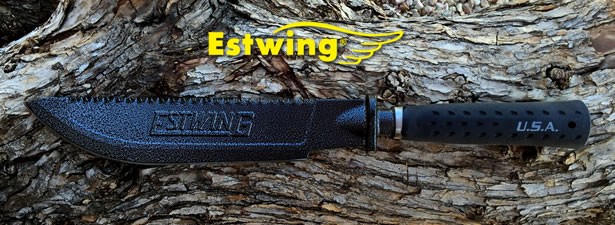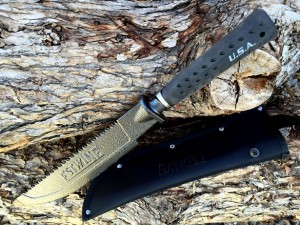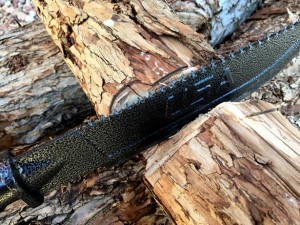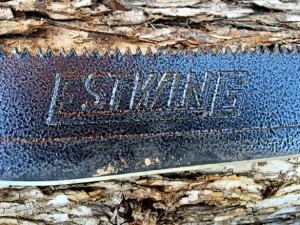Estwing Sportsman Machete Reviewed

Marketing from Estwing
The Estwing Machete makes the perfect outdoor utility tool. The hand sharpened edge clears brush with ease. Also perfect to cut and maintain trails, butcher wild game or maintain a campsite clearing. The sharp offset teeth will saw thru small branches or other various materials. It comes with a durable powder coat finish and the patented Shock Reduction Grip along with a nylon sheath with a belt loop.
Manufacturer: Estwing, estwing.com
Model: Sportsman MacheteOverall Length: 19.25″ (48.7 cm)
Blade Length: 12″ 30.5 cm)
Cutting Edge: 10.75″ (27.3 cm)
Thickness: 5/32″ (4.0 mm)
Material: U.S. Forged 1055 High Carbon Steel
Handle Material: Patented Black Nylon Vinyl Shock Reduction Grip
Handle Length: 6.75″ (17.1 cm)
Weight: 1.7 lbs (27 oz)Origin: Made in the USA
Estwing Model: EBM
UPC: 034139679332
MSRP: $52.99
The Review
As a compulsive gear junkie, I am always looking for new stuff to try out. On a recent trip through Home Depot to look at some hatchets and axes, I ran across some cool stuff and what I thought might be a new machete by Estwing called the Sportsman Machete… And I just had to give it a try for myself. After reaching out to Estwing, they graciously responded with one to show you, so let’s give it a go…

When I first picked up Estwing’s Sportsman Machete I was immediately taken back by the weight, balance and ruggedness of it. It not only looks like a wicked chopper, it feels like it can back up its mean attitude too.
There is not a whole lot of information available on this machete anywhere on the Internet so I am going to do the best that I can with what I’ve got… I think it must be a new product they are trying out since it is not listed on their website, and the only places that I’ve seen it available are Amazon, Home Depot and a few other online tool and knife shops.
The Sportsman Machete is forged from a stout piece of 1055 high carbon steel 5/32 of an inch thick for its incredible strength and durability making it virtually indestructible. The overall length of the machete is 19.25 inches, with 12 of them from the tip to the hilt taken by the blade. Although, the hand-sharpened cutting edge utilizes only the last 9.75 inches of the blade. Best of all, it’s made in the USA.
 The blade is powder-coated with a rugged antique-looking finish, so thick in fact that it is very difficult to tell exactly what kind of grind was used. However, it does look a lot like a hollow grind with a secondary bevel to me. The blade has a subtle drop point and 8.5 inches of sawback with sharp offset teeth along the spine. The spine does not have a sharp 90° edge for using a ferro rod. However, someone could easily remedy that with a good file.
The blade is powder-coated with a rugged antique-looking finish, so thick in fact that it is very difficult to tell exactly what kind of grind was used. However, it does look a lot like a hollow grind with a secondary bevel to me. The blade has a subtle drop point and 8.5 inches of sawback with sharp offset teeth along the spine. The spine does not have a sharp 90° edge for using a ferro rod. However, someone could easily remedy that with a good file.
The Machete’s black handle design encapsulates the tang consistent with most of Estwing’s hammer lines using their patented nylon vinyl shock-reduction grip. It is designed to be well-balanced, extremely comfortable to wield and absorb an incredible amount of shock thereby reducing injury and fatigue. My only issue with the handle is the warning message moulded into the right-side of the handle itself. The lettering could stand to be smoothed with a sander to prevent a hotspot when using the machete without gloves.
The sheath provided with the machete is made from a tough plastic-lined nylon fabric, reinforced with taped, stitched and riveted seams. The machete is held firmly in place with a single button strap. The nylon web belt loop is double-stitched onto the back of the sheath capable of supporting up to a 2.25 inch belt. There is a small vinyl tab at the sheath opening to prevent the saw teeth from damaging the nylon protective tape around the seams.
Functional Testing
Now lets see what Estwing’s Sportsman Machete can do… In order to provide a some sort of apples-to-apples comparison between blades, I will be performing six durability tests; Batoning, Chopping, Feather Stick, Sawing, Tip Strength and Edge Retention. In a survival situation, all resources are fair game. However, since I am not in a life-or-death situation, I’ll stick to some dead wood that I have lying around for these tests.
Batoning
For this test, I chose to baton a few small logs about 12″ long and 6″ in diameter. I used a 2.5″ baton about 2′ long to strike the spine of the machete. However, I was careful not to strike the sawtoothed section of the spine which was not easy to do since it only left an area on the spine no bigger than 1.5″. As the blade started through the log, the coating seemed to become sticky from the friction making it more difficult to get the blade through the log. I kept having this problem until the material was not much more than a couple inches in diameter. I think this will continue to be a problem until the coating wears off or I remove it altogether.
 Chopping
Chopping
Out of all of the tests, this is the one that I am confident Estwing’s Machete is going to excel at. To start, I chopped at some small vines and foliage as I delimbed a few branches. The machete easily chopped through anything and everything smaller than an inch in diameter. As the material became larger, a little more effort and multiple strikes were necessary.
Once I started chopping on a branch about 6″ in diameter, the machete really showed its stuff. the heft and balance of the machete allow you to drive the blade deeply into the material without much effort, and the shock absorption properties of the handle keep the fatigue in check. However, I am sure the stickiness of the protective coating was getting in the way here as well.
I found this machete’s ability to process heavy material to be more comparable to that of an extreme chopper or a small hatchet than with most machetes due to the extreme thickness of its blade. Whereas a typical machete has a much thinner blade designed for cutting through vines and foliage rather than chopping through heavy material.
Feathering A Stick
I tried feathering a few sticks varying in hardness, with only a minimal amount of success. The edge certainly seems sharp enough to make them, but I just could not get the edge to bite into the material to get the curling started. I am sure the thick blade attributed to this, but I feel it was mostly due to the sticky powder coating and the gummy buildup along the blade’s edge.
 Sawing:
Sawing:
Next, I used the Sportsman Machete to saw through a few branches during this test. The first branch was no larger than an inch and was not too difficult to cut provided it was supported and did not move. But as I went up in size, the difficulty rose dramatically. Again, I was combatting the protective coating which was gumming up and causing the blade to drag and bind.
Tip Strength
To test the tip of the Sportsman Machete, I drove the tip of the blade into the end of a 12″ diameter stump as hard as I could. Then I loosened it using a side-to-side motion until it was loose enough to pull out. I repeated this process a few more times just to make sure the tip thoroughly being tested.
Next, I used the tip of the Sportsman Machete to bore a cone-shaped hole into the side of a small log approximately 1″ in diameter and about 1″ deep by twisting the blade back and forth until the hole was deep enough. The tip of the blade is stout and certainly tough enough to handle this task without issue.
Edge Retention
After all of the other functional testing had been completed, the final test for the Sportsman Machete was to slice through a single-sheet of computer paper to demonstrate its ability to hold an edge. The blade easily survived all tests without any sign of cracks, chips or other imperfections of any kind with the exception of the heavy wear and buildup on the blade’s protective coating. Even with this, the blade remained sharp enough to slice through a sheet of paper cleanly without needing any tuneup.
Final Thoughts
Estwing’s Sportsman Machete is a rough and tough piece of hardened steel capable of inflicting some serious damage to anything in its path. It is a rock-solid performer whether it be clearing brush to maintain a trail, processing firewood or campsite management, but it does have one serious flaw that is not all that difficult to overcome. With a few power tools and a little bit of elbow grease, you can strip that nasty coating off and leave all your troubles behind.
![]()
About Estwing
![]() Since 1923, the Estwing family and its employees have taken pride in designing and manufacturing the world’s most durable, comfortable and attractive striking and struck tools. All claw hammers, axes, specialty tools and pry bars are manufactured to the highest possible standards and offer a true value to both tradesmen and craftsmen alike.
Since 1923, the Estwing family and its employees have taken pride in designing and manufacturing the world’s most durable, comfortable and attractive striking and struck tools. All claw hammers, axes, specialty tools and pry bars are manufactured to the highest possible standards and offer a true value to both tradesmen and craftsmen alike.
In 2001 Estwing introduced the new shock reduction grip that provides our customers with the best available grip for reducing vibrations caused by impact. Plus, this grip offers the utmost in both comfort and durability. This Estwing patented innovation is sure to be the standard for ergonomically correct hammers for decades to come. All of our nylon vinyl grip tools are now being made with this new material.
Estwing continues to innovate and produce new hand tools. Our engineers work continually to create the most revolutionary and long lasting hand tools on the market. Estwing is committed to American made tools for today and tomorrow.
--